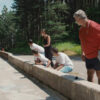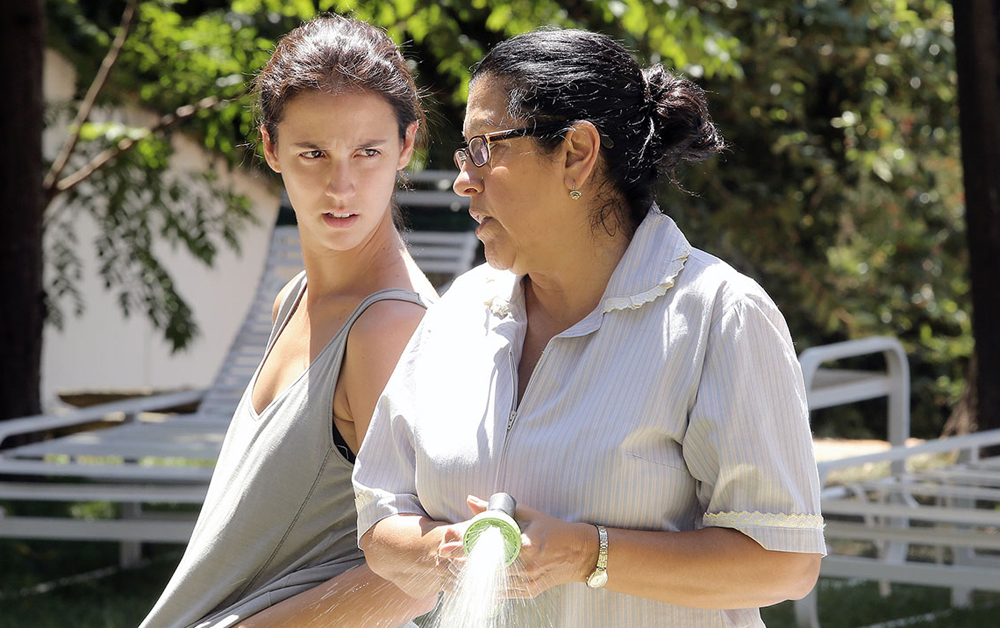For a film that’s largely contained to one location, “The Second Mother” writer/director Anna Muylaert had likely imagined that taking her cast and crew outside would’ve provided a breath of fresh air. Yet a day spent in public with one of Brazil’s most famous actresses was anything but.
“Regina Casé is a big star here, like Oprah Winfrey, and there was no air conditioning, so can you imagine Oprah Winfrey without air conditioning,” laughs Muylaert now. “She was really nervous and everybody’s brain was fried. Everybody was fighting. I had a fight with my [cinematographer]. We wound up having to re-shoot.”
Inside the house where Muylaert primarily sets “The Second Mother,” however, was a different story. With Casé playing a housekeeper for a well-to-do family, the filmmaker cleverly used her lead’s public persona as just one way to speak to the plight of Brazil’s lower class and the sacrifices that are often made to give future generations a better future. However, that isn’t the only thing that’s turned on its ear in the film, which sees the family that Casé’s Val takes care of upended by the arrival of her college-aged daughter Jessica (Camila Márdila), who plans to attend university in São Paulo. The two haven’t seen each other for nearly a decade, with Val having a closer relationship with Fabhino (Michel Joelsas), the son of her employers, than her own flesh and blood. Yet Jessica seems more at ease in the house Val cleans than any of its tenants – a patriarch (Lourenço Mutarelli) whose inherited wealth may provide one kind of comfort but drained him of ambition, his wife (Karine Teles), a self-made stylista, their son, whose hormones are a cause of concern, and Val herself, who strives to maintain professionalism though her guilt about not being around her daughter for so long — and then subsequently wondering if she actually feels guilty for what she believed was in her daughter’s best interests — weighs on her throughout the film.
There’s a gracefulness with which Muylaert tackles such thorny subject matter, nuance that surely was derived from the 20 years that the filmmaker spent nursing the screenplay. In that time, Muylaert became one of her country’s most respected filmmakers, asked to dine with the president when a summer of female filmmakers was convened. With cinematographer Barbara Alvarez’s sharp camerawork in “The Second Mother,” every frame of the film is immaculately composed, even as the characters lose their composure within it, and as gently as it unfolds, the film ultimately packs a wallop as it becomes clear that it isn’t only the fate of this family on the line, but the underpinnings of Brazil’s class system. Shortly before “The Second Mother” is released in the U.S. following a celebrated festival run that included awards at Berlin and Sundance earlier this year, Muylaert spoke about taking a different angle, both to the idea of motherhood in Brazilian culture and visually within the film to create such an emotionally stirring drama.
It started when I had a son. I wanted to stay with him, but at the same time, I wanted to work, and I didn’t want anybody to take care of him. Everybody around me had nannies, and I didn’t feel comfortable with that. Then I started to think about his character. You have a child, then you have to leave it with someone else who has such a low salary. I started thinking that the work of the mother is not valued in Brazil, but for me, it’s sacred work. It was the most important work I had ever done. All of these mixed thoughts and feelings made me want to make a film.
That was 20 years ago, because it was such a complicated issue that in the beginning I thought I was not mature enough to direct this film. I worked on it for about two-and-a-half years. The title then was “The Kitchen Door,” and when it was ready, I said “I cannot direct this now,” so I put it down and I did two films before this one. I said, “Now, my kids are bigger. I have more experience as a writer and director.” I started researching again, but it’s the same story.

Yes. In the original version, Jessica came to Sao Paulo and wanted to become a hairdresser, but she was so weak that she couldn’t even do that, and in the end, the last scene was just like the first scene: she became a nanny. That was the story for many years. But Lula [the president of Brazil from 2003-2011] did all the changes to put people into university and his citizenship idea, and there were all these films like “Neighboring Sounds,” a film I love, by Kleber Mendonça Filho, talking about these changes. So I went to a [writers’] lab and there was an American consultant there who told me, “Anna, your script is very good. It’s clear that you want to talk about the social issues in your country, but if your mother was a housemaid, wouldn’t you like to give her a more hopeful ending?”
That question was in my mind for about five years. [laughs] Six months before shooting, I locked myself in the house and [said], I have to find a new way. I didn’t want a false happy ending. One day the idea came to me, she’s not coming to be a hairdresser. She comes as a citizen and she wants to study architecture. From that point, the whole story changed. I wrote it like in two weeks, and it’s my oldest project, but it was the freshest script I ever filmed and of course, it’s about the new Brazil. I wasn’t aware of that [relevance]. I was just trying to deal with the character, but when the film was first shown in Locarno, everybody was like, “Wow, this is [watching] history.” That wasn’t my intention, I was much more into dramaturgy.

I do rehearse, but I don’t like to rehearse the scenes of the film. I like to rehearse the character. For example, my first rehearsal with Regina [Case] was with her and Helena [Albegaria] in the kitchen baking something, a cake. They were just talking about the purpose of cleaning products, just random talk, so as [to summon] the character could come, but not read actual scenes. [The actresses who played] Val and Jessica rehearsed for one afternoon [by making] all of the phone calls during the ten years they didn’t see each other and I gave them a script, so the tension was growing. I talk with the [actors] a lot about the function of the scene. I’m very scientific — I do graphics, I do many things to say this is the emotion you have to get to because you come from here, you go there, so there’s a big sense of where to go, but I don’t like them to do the same words that I’ve written. I like to collaborate. I like for them to co-create, so it’s a mix of letting them be totally free but giving them [a direction on] exactly where to go from.

The house was not really what we were looking for because I wanted a modernist house [suggesting] a higher educational [background]. But I normally do something called “demo film” — like musicians who do the demo takes. So I went in the house without already having chosen it, with the actors, myself, one assistant, and the camera and I shot the whole film in two days — like 60 scenes, but very badly done, just one scene after another. That’s the way of approaching the film with the possibility of intuition because I don’t have the crew and the weight of the crew. I did all that and it worked. Many of the shots were designed in this process. We saw what worked, then we decided to pick the house, but my production designer did some changes because there were a lot of curves that we didn’t want. So we did some makeup on the architecture of the house to make it more modernist.

That’s the political shot. I discovered that in the rehearsal – the “demo film” days. I had the influence of an Argentinean film called “El Custodio,” which is “The Bodyguard” in English and photographed by the same [cinematographer] of my film, Barbara Alvarez, who’s Uruguayan. This film talks about this bodyguard and everything that happens to the minister [he protects], but you never see [the minister]. When the minister goes inside the house, in a certain room, they close the door in your face and you’re out. That’s what inspired how we’d use the camera [in this film] — the idea that you’re out of the frame of the main scene. When I found that [particular] place [in the house], I had the strange feeling for the first time in my life understanding what it is to be in the perspective of the kitchen because I was born in the living room. Before doing this film, I had never felt that. I thought it was so beautiful and I was so moved, it became the main place for the camera. When the [cinematographer] came, she would get upset with me because she’d say, “It’s here again,” and she would get tired [of it], saying, “Let’s move it.” [laughs] “No, it’s here,” [I’d say] Then she recognized it was very important for the film to go there many times.
The film is very self-contained. Was that the plan from the start or did you ever think you’d venture out of the house?
Yeah, in the [original draft], they had a trip to the beach and all the swimming pool stuff was going to happen there. But again, we decided to keep in the house for budget issues and you know also for the simplicity. I had just written the final draft, and I showed it to my production designer and he said, “You have to see ‘Teorema’ by Pasolini because your film is very much going that way.” Then I saw it, and indeed, they have the a dramatic structure that’s very much the same, inside the house and that gave me confidence that would be the right way, to stay there all the time.
“The Second Mother” opens on August 28th in Los Angeles at the Royal and New York at the Angelika and the Paris before expanding. A full list of theaters and dates can be found here.





